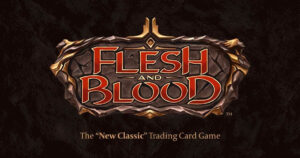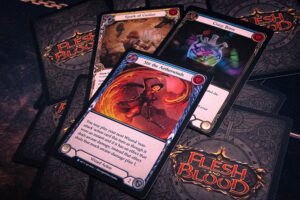 My start with tabletop gaming was playing Magic: The Gathering in high school. After that, I spent untold thousands of dollars on little rectangular slices of cardboard and traveled all over the greater midwestern United States competing in events. While for the past 10 years or so I’ve barely played any Magic in person, I still play quite a bit on the MTG Arena app.
My start with tabletop gaming was playing Magic: The Gathering in high school. After that, I spent untold thousands of dollars on little rectangular slices of cardboard and traveled all over the greater midwestern United States competing in events. While for the past 10 years or so I’ve barely played any Magic in person, I still play quite a bit on the MTG Arena app.
And what does this have to do with Flesh and Blood? Well, everything. Collectible card games seem to keep coming and going and only a few have withstood the test of time. But if you are at all involved in competitive card games, you’ve probably heard of Flesh and Blood. It is aiming to be the next big thing and they might just have the game here to do it.
Gameplay Overview:
In Flesh and Blood, you’ll choose a hero and build a deck around them. In the most recent set, Monarch, there are four heroes:
- Boltyn a light warrior
- Prism a light illusionist
- Chane a shadow runeblade
- Levia a shadow brute
When you build your deck, you can include generic cards and cards that match your hero’s class or talent. Boltyn, for instance, can include light cards, warrior cards, and generic cards. You also get to choose a weapon and four pieces of equipment (head, arms, legs, and chest) that start the game in play. Each player will draw four cards to start their turn and then start their battle.

At the beginning of your turn, you get a single action point. You can use this action point to play an action card from your hand or activate any card already in play. For the most part, this will be an attack and you must pay the card’s cost—printed in the red circle in the top right—by pitching other cards from your hand. Each card generates 1-3 resources and is indicated by a colored bar at the top of the card: red generates one, yellow two, and blue three. The cards you pitch go on the bottom of your deck at the end of your turn.
After you play an attack, the defender can use any number of cards from their hand to defend. The number of shields in the bottom right of the card will reduce the damage from the attack by that amount. Then both players could play reactions before the damage finally resolves. Some actions will grant the ability to go again. As you might guess, this lets you take another action after that action has resolved.

After you’ve used all your action points, if you have any cards remaining in hand you can put one card face-down in your arsenal. You can only ever have one card in your arsenal, but you can play it on a future turn, but it can’t be played just for its defense value. You then draw back up to your hand size of four cards. Importantly, only the active player draws so if the defender uses cards to block, they won’t replace those until their next turn is over.
It is worth reiterating Flesh and Blood is a collectible card game, through and through. It’s not a living card game or expandable card game. This is the booster pack cracking, hoping for the card you need, trading with your friends type of game. There are some preconstructed decks you can buy to get started and then modify from there. But the process of acquiring the cards you want is very much like Magic or Pokemon card games. And currently prices for single cards on the secondary market are notably higher than other card games.
If you are looking for a place to start, the preconstructed blitz decks are the place to go. You’ll get a 40-card deck with a hero, weapon, and equipment and be able to shuffle up and play right away. There are also draft and sealed formats where you open booster packs and build your best deck from the cards available in that pool.

Game Experience:
There is quite a lot of depth in the gameplay of Flesh and Blood. Even before you start scratching the surface of the deck building aspect. Each hero has a bit of strategy that they are trying to execute. Prism can make aura tokens that she can then turn into powerful weapons, but they disappear when she takes damage. Chane quite literally shackles his soul to the shadow realm (or something, I’m not up on all the lore) to banish cards from the top of his deck every turn. Some of those cards can be played, giving him extra options. But they will also do damage if they remain in the banished area at the end of his turn.

A lot of the game is centered around when to take damage and when to block. Every card you block with is one less card you’ll have to use on your turn. Sometimes if you have just the perfect combination of cards in your hand, you’ll take a boatload of damage to be able to maximize your own turn. In other cases, you just preserve your life total and hang on for a better time to get tempo back in your favor. There are definitely heroes that can block effectively and only need a card or two in their hand on most of their turns, but other types of decks will falter if pushed to defend repeatedly and will have to take more chances to get back on the aggressive.
Another somewhat subtle part of the design of Flesh and Blood is the pitching of cards for resources. In most games you will get through your entire deck and eventually be drawing the cards you pitched in the first few turns. So carefully deciding what to pitch so that it’s available later in the game is another level to consider throughout. Not to mention trying to keep track of what your opponent has pitched so you know what their options will be as the game draws to a close.
But it’s not just the hero that informs your strategy but their equipment and weapons too. Maybe the Prism deck that attacks with big powerful auras just isn’t working out for you. Trade your Iris of Reality for Luminaris. Now your auras attack for one damage, instead of four, but don’t cost any resources to use. And while Monarch only has four heroes there are 19 available in total. Maybe you don’t like how Boltyn works but you have warrior-class cards you love? Substitute in Kassai or Dorinthea and see if their ability suits your deck.

So, the fine folks at Legend Story Studios, the publisher of Flesh and Blood, were kind enough to send us a couple of preconstructed blitz decks to review. And within a few days of playing the first time, I may have become slightly addicted and ordered four entire booster boxes and cracked packs like my old MTG-loving days. I will say the collectability of games doesn’t necessarily bother me, but Flesh and Blood has turned it up to 11 here. With each new set, the first-edition printing comes out sooner and includes some very rare “cold foiled” cards. First edition boxes go for about 5x the price of the standard “unlimited” versions and the rarest cards, which are in about 1-in-1000 packs command huge prices.
Of course, you can just not worry about first edition or fancy “cold foiled” versions of cards and play the game for a moderate amount of money. Still, competitive tournament types of decks will likely be setting you back easily $500. Currently, LSS has said there won’t be any type of rotating format, but some heroes will be retired once they reach a certain level of success. Hopefully, that means having to buy a completely new deck will be fairly rare. And I’ve played a few games of the sealed format and it’s just as much fun as the constructed version. So, playing a limited format to help build up your collection is certainly a viable plan.
Final Thoughts:
Not every gamer is going to be into the tournament-level collectible card game market. But if it’s even remotely interesting to you, I think you should be looking at picking up at least a couple of blitz decks and seeing what all the buzz is about. The gameplay in Flesh and Blood is very easy to learn but provides a lot of depth and decisions to make every single turn.
It’s managed to really thrive during a pandemic, which is saying quite a lot for a game that is dependent on playing events in person. There are some awesome online communities that have popped up and with in-person events starting to happen, I’m excited to find some stores running Flesh and Blood tournaments.
Final Score: 4.5 Stars – The most strategic CCG since Magic with a much smaller learning curve.
 Hits:
Hits:
• Blitz decks provide a great entry point for a cheap, but full, experience.
• Sealed format works well.
• Lots of subtle, emergent strategies as you play more games and understand the interactions.
Misses:
• Collectible games aren’t cheap
• First edition pricing is pretty nuts.






















